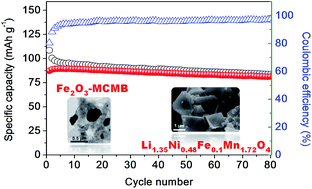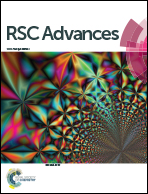A lithium ion battery exploiting a composite Fe2O3 anode and a high voltage Li1.35Ni0.48Fe0.1Mn1.72O4 cathode†
Abstract
In this paper we report a new lithium ion battery (LIB) consisting of a conversion-type, high capacity Fe2O3–Meso Carbon Micro Beads (MCMB) composite anode and a high voltage, Li1.35Ni0.48Fe0.1Mn1.72O4 cathode, prepared by using facile, low cost synthetic pathways. These electrodes have been characterized by a series of techniques including scanning and transmission electron microscopy, X-ray diffraction analysis, potentiodynamic cycling with galvanostatic acceleration (PCGA) and galvanostatic cycling tests in lithium cells at different C-rates. The results show that the Fe2O3–MCMB anode benefits by a composite, sub micrometric morphology and by a stable specific capacity ranging from 800 to 600 mA h g−1, evolving around 0.9 V, while the Li1.35Ni0.48Fe0.1Mn1.72O4 cathode is formed by an agglomeration of micrometric crystals delivering a reversible capacity of about 115 mA h g−1 at a 4.7 V high voltage. The combination of the Fe2O3–MCMB anode with the Li1.35Ni0.48Fe0.1Mn1.72O4 cathode leads to a complete lithium ion battery having an operating voltage of about 3 V, a high coulombic efficiency and a stable capacity of about 100 mA h g−1, which translates into in a theoretical energy density of about 300 Wh kg−1.


 Please wait while we load your content...
Please wait while we load your content...